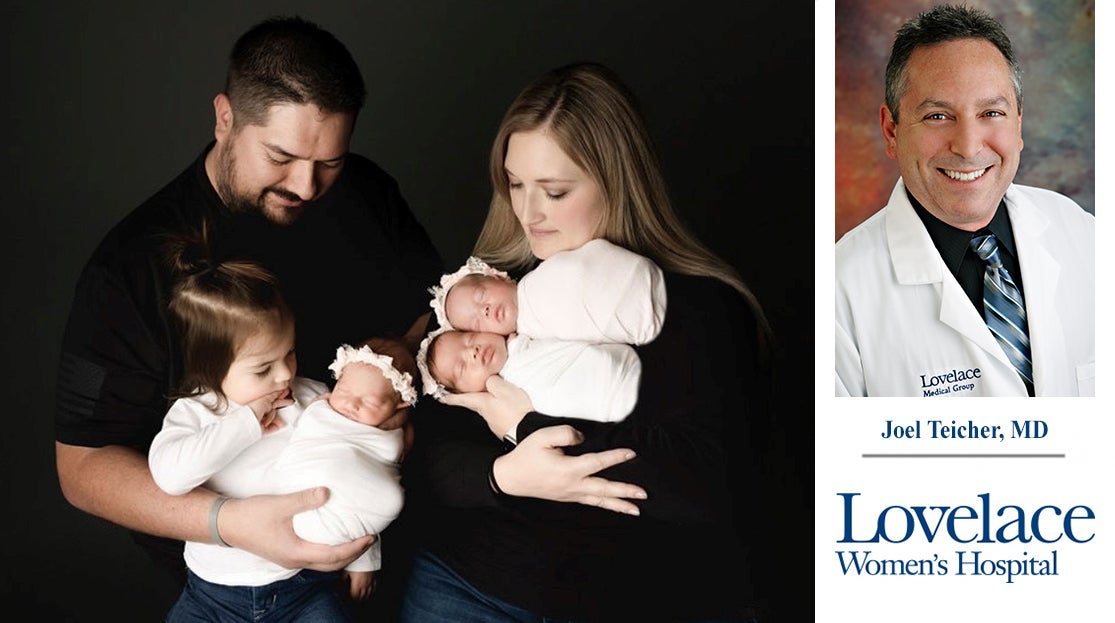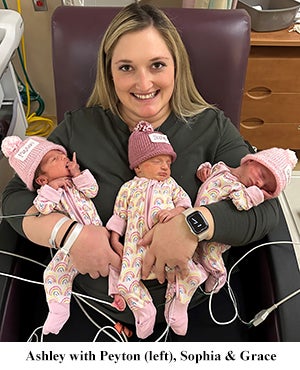
When “delivery day” finally arrived for Ashley and Enrique Lucero, residents of Rio Rancho, Ashley walked into the hospital and introduced herself to the receptionist. “Oh,” she said, “you must be the triplet mom!”
With that news, the delivery staff at Lovelace Women’s Hospital sprang into action. They wheeled Ashley down the hall to a preparation room, right across from where her C-section would happen. Ashely changed into a gown and the nurses hooked her up to an IV to get fluids started. They also drew blood to get baseline numbers for lab reports.
Once the whirlwind of activity settled down, Ashley waited until it was time for surgery.
Family history
This was the second pregnancy for Enrique, 29, a diesel truck engineer, and Ashley, 29, a nurse who used to work in the NICU at Lovelace Women’s Hospital. Their daughter Scarlett was born 21 months before the triplets.
So even though Ashley was prepared for pregnancy and morning sickness, she noticed that it was much more pronounced this time. That’s why she and Enrique were not really surprised when the ultrasound at 9 weeks showed that she was carrying twins.
“Twins run in our family,” Ashley said. “All told, there have been 19 sets of twins on my Dad’s side.” With this news, Ashley and her babies were deemed ‘higher risk,’ so she was referred to a specialist: Joel Teicher, MD, FACOG.
“I knew Dr. Teicher when I worked in the NICU,” Ashley said. “He’s the top-rated OB doctor when multiples are born.”
Then at her 12-week appointment with Dr. Teicher, Ashley had another ultrasound but with a different result. “When they looked at the ultrasound and saw that there were triplets, I just started laughing. That explains why my nausea is worse!” she said.
Not only was her nausea worse, but she thought it was strange that she wasn’t craving any special foods during her pregnancy.
“When I was pregnant with Scarlett, I would crave the green chili sauce at Bob’s Burgers, as hot as they could make it,” she recounted. “Sometimes I’d get a burger, other times I’d get some green chili cheese fries. I would eat it all the time. I don’t know why I didn’t crave it with the triplets.”
By now, Ashley and Enrique knew that 3 girls were on the way and they had their names ready: Grace, Sophia and Peyton.
As the triplets grew and developed, Ashley knew that birth by Cesarean section would be the preferred delivery method to minimize the risks with 3 children involved. Delivery by C-section is used primarily when the mother’s or baby’s health may be in danger.
Her doctor monitored the triplets’ growth at every visit by sonogram, which uses high-frequency sound waves to create visual images of the inside of patients.
“They measure the circumference of each baby’s head and belly,” Ashley said. “Then they measure the length of one arm bone and one leg bone. By knowing these measurements and how many weeks they’ve been developing, the doctors can estimate how much each child weighs and how they compare to the national averages.”
The goal was to keep the girls in the womb until the 36th week, which is full-term for triplets, compared to a regular 40-week gestation period. But by the 32nd week, Grace’s growth was slowing down. She was long and normal size, but she had the lowest estimated weight.
“Eventually the doctors and nurses told me, ‘We’re concerned that if we leave Grace and the others in too long, Grace may stop growing or something else may happen,’ so we scheduled the C-section for the 4th day of week 34,” Ashley explained.
Time for surgery
On January 10, Ashley and Enrique walked into the hospital and got ready for surgery. The labor and delivery department was buzzing with the news that the triplets would be born that day.
“I was fortunate to know many of the OB nurses and doctors from the time I worked in the NICU,” Ashley said. “My friend Jessica was working that day, so it was nice to have her there with me. The staff on the delivery floor and the NICU were so organized and wonderful.”
Ashley was still in the prep room when she met with the anesthesia staff who explained how the epidural worked. They would inject the anesthesia into the epidural area of the spinal cord which would create an area of numbness from her belly button to her upper legs. This would allow Ashley to remain awake and alert during the surgery without feeling any pain, only a little pressure.
Dr. Teicher then came in to check on the progress of the epidural and see if Ashley and Enrique had any other questions. Soon after that, they took her across the hall and into the operating room.
“They had a curtain drawn above my belly, so I couldn’t see what Dr. Teicher was doing,” Ashley said. “I couldn't hear anything. Then I heard, ‘Okay, you're going to feel a lot of pressure’ and they pushed on my stomach.”
“Dr. Geralde, a neonatal baby doctor who was assisting, was very nice and could see the babies being delivered, so he provided a play-by-play account of what was happening on the other side of the curtain.”
“Okay, the first baby’s out. She's breathing. She's crying. She has good color. Looks like their lungs are still a little bit sticky, so we may have to give them medication to open them up.”
“And just like that, within 5 minutes, all 3 were born,” Ashley said.
As the doctors finished up with Ashley, Enrique followed the babies to the NICU.
Ashley recovered from surgery for 4 nights before being discharged. Since the triplets were just in their 35th week, they stayed in the NICU until they weighed at least 4 pounds, the legal minimum for riding in a car seat.
 Home with 3 new personalities
Home with 3 new personalities
After a 12-day stay in the NICU, Peyton and Sophia were able to go home. Grace, who was the firstborn and the smallest, stayed 9 more days in order to gain enough weight, but finally was able to go home.
As they get to know their newborns, Ashley and Enrique are starting to see little differences between the 3 of them.
“Grace and Sophia are identical and look more like me,” said Ashley. “However, Peyton has a full head of dark hair and looks more like Enrique and Scarlett.”
“It's funny because since Peyton was higher in the womb and by herself, she was the bigger one when they were born,” Ashley said. “Now she's the middle one as Sophia has passed her in weight. We believe Sophia was the calm one in the womb, as she was positioned really far down, by my pelvis. Now Sophia is very dramatic and has a piercing scream. Finally, there’s Grace, the smallest of them all. She’s the most active one!”
Fortunately, Ashley and Enrique have family close by to help with all 4 girls.
“My brother and his wife live around the block from us, while my parents only live 12 minutes away. Enrique’s mom is less than 10 minutes away. We have a really big family, so we will have lots of visitors,” she said.
Having lots of hands nearby will certainly help with feeding times. To help the girls gain weight, Ashley adds baby formula to each bottle of breast milk.
At the time of this interview, the triplets were already a month old. “How did that happen?” said Ashley.
“People say that at this age, the days are long but the years are short as time flies by. I don’t know about that. Our days seem short, especially when feeding them every 3 hours. It takes us almost an hour to feed all 3. By the time we lay them down, we only have 2 hours before we start again. The whole day and night is a blur; it just flies by!”
Fortunately, there will be many hands around to help feed the many mouths.
For more information about the birthing services at Lovelace Women’s Hospital, visit our web page or call 505.727.7677.




